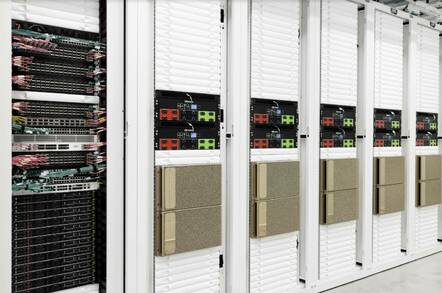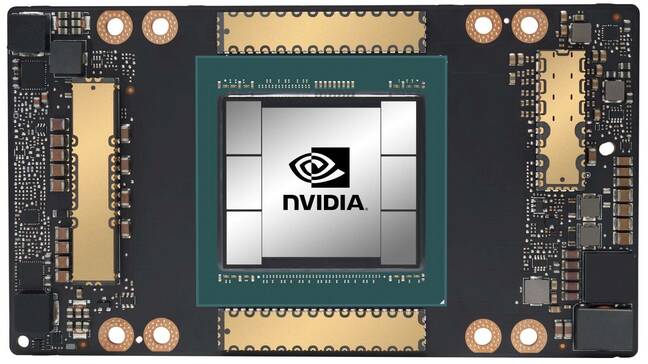This article is more than 1 year old
Nvidia launches Cambridge-1, UK's most powerful supercomputer, in Arm's neighbourhood
Plus: free supercomputing for 5 healthcare partners. Charm offensive to support Arm takeover plans?
Nvidia has launched its Cambridge-1 supercomputer, with a focus on AI for healthcare, as part of larger plans to boost AI research in the university city itself and more widely across the UK.
The Cambridge-1 is the highest ranking supercomputer in Britain according to the Top500 list, currently sitting in 41st place globally with maximum performance of 9,682 TFlop/s – though the world's fastest, the Supercomputer Fugaku, can manage 442,010.
The supercomputer was announced in October last year at which time it was slated to "come online by year end," so it is somewhat delayed, but still constructed rapidly thanks to the use of Nvidia's modular DGX SuperPOD, described as a "turnkey AI data center."
The actual deployment of the supercomputer took less than 20 weeks, Nvidia told us. Costs have increased a bit though: the October post talked of a £40m investment, while at today's launch the figure given was $100m (over £72m).
The Cambridge-A1 consists of 80 DGX A100 systems connected by Infiniband networking. Each DGX A100 has 8 A100 GPUs, 320GB GPU RAM, two AMD EPYC 7742 CPUs (64 cores each), up to 2TB system RAM, up to 30TB NVME data cache drives, and 2 1.92TB NVME SSDs.
The A100 GPU is Nvidia's high end Ampere GPU, following on from the Tesla V100; it is described in detail here. There are 6912 CUDA (Nvidia's GPU programming platform) cores per GPU, to support massively parallel computing – and there is a total of 640 A100 GPUs in the system.
The only way is Essex
The physical location of the Cambridge-1 (despite the name) is Harlow, in Essex, at the data centre of Kao Data, chosen in part for its green credentials: the company claims to use 100 per cent renewable energy, meet the EU's data centre environmental guidelines, and use 100 per cent free cooling, meaning that cool air comes from the external atmosphere. Harlow is on the "Cambridge to London UK innovation corridor," said Kao Data, doing its best to associate Harlow with Cambridge.
"It's our first dedicated supercomputer for healthcare, and probably in the world," said David Hogan, veep of Enterprise EMEA at Nvidia.
Science and medicine aid
The initial setup involves five "founding partners."
These are GSK, AstraZeneca, Oxford Nanopore, Kings College London (KCL), and Guy's and St Thomas NHS Foundation Trust.
We spoke to Professor Sebastien Ourselin at KCL, head of biomedical engineering and imaging sciences. Ourselin is also deputy director of the AI Centre for value based healthcare, a joint project primarily between KCL, Guy's and St Thomas', along with other NHS trusts, universities and technology vendors including Nvidia.
"For the past three-and-a-half years, Nvidia has been our main partner in our program of artificial intelligence in healthcare at Kings," he told The Reg.
Ourselin said the capacity of Cambridge-1 is necessary for its healthcare AI to be equitable and accurate. "With AI, there are two big challenges to solve. One is access to data at scale, and second, access to computational power at scale. A lot of people can build AI models. The challenge is how to make sure it can translate into an unbiased, equitable model, and to do that, especially in healthcare, you need access to a huge amount of data which are representative of your population.
"For Nvidia being part of a consortium like the AI Centre was a way of getting access to a lot of data in collaboration with us and help us to train these models," he said.
KCL specialises in AI based on image data such as MRI scans. "If you try to prognose or diagnose based on image information, you base everything on training. So what you ingest is what the algorithm will be able to learn with. If now your population is, let's say, only Caucasian, what happens if you now present non-Caucasian data? It might not work.
"What if your dataset only represents a healthy population? It might never find any disease. What if the dataset is only males? If you want to increase the dataset, the model becomes much more complex to explain all of the data. And the only way is to have large computational power. That is where Cambridge-1 came into play; it enabled us to train models at a scale we were not able to do before," he said.
KCL has its own supercomputer which is "much smaller than Cambridge-1," Ourselin said. This meant that testing a new model might take three weeks, limiting the number of feasible tests. "If you can get an answer overnight you can accelerate the research," he said.
Data protection
Privacy is an issue. "Data coming from the NHS will be transferred to the supercomputer in a fully secure enclave so the only people who can access the data are the people from the hospital. In all the experiments we are doing, the data will never be seen by anyone else. It is as if the supercomputer were an extension of the hospital.
"The idea is to build what I call a smart NHS where you can send a vast amount of data without having to anonymize, to get the full richness of the data, and you are able to build models which are multi-dimensional," he said – words that may concern privacy advocates, since leaks of supposedly secure data are not unknown.
What will be the cost to KCL? "We don't pay for this resource. It is provided pro bono by Nvidia, which invested over £40m in the supercomputer. We don't pay anything. We're not charged for the usage of the supercomputer. And we keep all the intellectual property we generate. There is no financial model where we have to pay for anything."
The initial access is for one year, Ourselin told us, but he expects the subsidy to continue, "because we show them value."
What is the value to Nvidia?
"The CEO Jensen [Huang] was very keen to contribute, for society, not fully based on a financial model, but to demonstrate that AI can have a positive impact on society," said Ourselin.
"Nvidia offered not only to provide Cambridge-1 to those five founders, but to provide it to a much larger community in the future. To be able to do that, they wanted first to demonstrate through a set of concepts that adding such capability will actually be transformative."
- Chinese chip designers hope to topple Arm's Cortex-A76 with XiangShan RISC-V design
- AMD opens wallet to lure scientific computing boffins away from Nvidia's CUDA onto its Instinct accelerators
- RISC-V boffins lay out a plan for bringing the architecture to high-performance computing
- Bull in a cosmos shop: Edinburgh uni boffins strike deal with Atos for BullSequana supercomputer
- America to get world's 'most powerful' AI supercomputer to create the most detailed 3D map of the universe yet
This may be true; but we note that Nvidia is in the process of acquiring Cambridge-based Arm, subject to regulatory approval, and keen to put this transaction in the best possible light.
Nvidia has a sub-site on the matter, including a page on "Our vision for the UK" which states that "Nvidia intends to fulfill its vision of creating the leading computing company for the age of AI here in Cambridge – propelling Arm and the UK to global AI leadership."
Specific plans include a "new world-class AI research centre" of which Cambridge-1 is part. Cambridge-1 is AMD-based, but the company plans a future supercomputer "powered by Arm CPUs and Nvidia GPUs … at the iconic headquarters of Arm." Cambridge-2 perhaps?
Still, as Ourselin told us, Nvidia planting a supercomputer in Brexit-stricken UK is a nice boost at a difficult time. "There is a lot of reason for celebrating why a US company comes to the UK and invests in the UK. They could have put a supercomputer anywhere in the world," he said. ®


